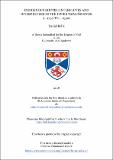Files in this item
Indigenous routes : interfluves and interpreters in the upper Tapajós river (c. 1750 to c. 1950)
Item metadata
| dc.contributor.advisor | Harris, Mark | |
| dc.contributor.advisor | Gow, Peter | |
| dc.contributor.author | Belik, Daniel | |
| dc.coverage.spatial | 292 p. | en_US |
| dc.date.accessioned | 2018-09-28T09:47:39Z | |
| dc.date.available | 2018-09-28T09:47:39Z | |
| dc.date.issued | 2018-12-07 | |
| dc.identifier.uri | https://hdl.handle.net/10023/16099 | |
| dc.description.abstract | This thesis is an ethnographic account of the indigenous history and colonization of the upper Tapajós river in Brazil. Research was conducted using archival materials in which I searched for the different conceptualizations of river movements and routes, of either Indians or colonizers. During the period of penetration in the region called “Mundurucânica”, several native groups living in the savannah and at the riverbanks, started to be used as a labour-force, but above all, they worked as interpreters thereby enabling colonization on these Amazonian rivers around the Tapajós. If, on one hand, native groups were violated by colonization, on the other, they have shaped and influenced the penetration, demonstrating their active involvement in this historical process. With the arrival of Franciscan priests and the ultimate establishment of the Cururu Mission, exchanges between indigenous people and colonizers became impregnated with mythical fragments. These relations of displacements and encounters between indigenous groups—that in turn influenced colonization efforts—with local cultural values and practices is still a relatively little explored topic in anthropology. This thesis synthesises the history of the colonization of a region of the Brazilian Amazonian rainforest from the point of view of its indigenous inhabitants. It considers the pacification of the Indians in the 18th and 19th centuries, presenting ethnographic material of the indigenous groups that have moved into the Tapajós region and examines their social logic of interethnic contact. I analyze fragments of material culture, myths and naming such as they appear in the literature so as to track down the spatial dynamics of indigenous Amazonia and its landscape transformations. | en_US |
| dc.language.iso | en | en_US |
| dc.publisher | University of St Andrews | |
| dc.rights | Attribution-NonCommercial-NoDerivatives 4.0 International | * |
| dc.rights.uri | http://creativecommons.org/licenses/by-nc-nd/4.0/ | * |
| dc.subject | Tapajós river | en_US |
| dc.subject | Indigenous routes | en_US |
| dc.subject | Ethnonyms | en_US |
| dc.subject.lcsh | Tapajós River (Brazil) | en |
| dc.subject.lcsh | Names, Ethnological--Brazil--Tapajós River Valley | en |
| dc.subject.lcsh | Indians of South America--Brazil--Tapajós River Valley | en |
| dc.subject.lcsh | Indians of South America--Brazil--Tapajós River Valley--Colonization | en |
| dc.title | Indigenous routes : interfluves and interpreters in the upper Tapajós river (c. 1750 to c. 1950) | en_US |
| dc.type | Thesis | en_US |
| dc.contributor.sponsor | Leverhulme Trust | en_US |
| dc.type.qualificationlevel | Doctoral | en_US |
| dc.type.qualificationname | PhD Doctor of Philosophy | en_US |
| dc.publisher.institution | The University of St Andrews | en_US |
| dc.publisher.department | Centre for Amerindian, Latin American and Caribbean Studies (CAS) | en_US |
The following licence files are associated with this item:
This item appears in the following Collection(s)
Except where otherwise noted within the work, this item's licence for re-use is described as Attribution-NonCommercial-NoDerivatives 4.0 International
Items in the St Andrews Research Repository are protected by copyright, with all rights reserved, unless otherwise indicated.


